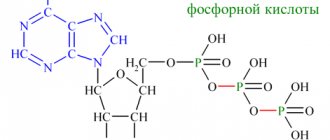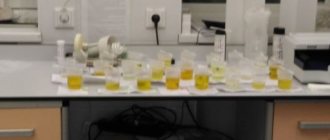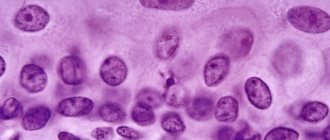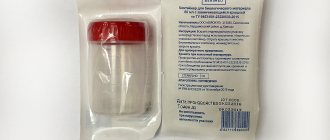With the development of any pathology, diagnosing the disease begins with testing. The doctor cannot confirm the diagnosis without a complete examination of the patient. Studying blood and urine provides an assessment of a person's health status. For example, when it comes to pathological processes that form in the pancreas, amylase in the urine is checked. Any deviation from the norm in the conclusion of the analysis can affect the general well-being of the patient.
Amylase is an active enzyme substance involved in digestive function. Under his leadership, the breakdown of complex carbohydrates occurs, which has a beneficial effect on intestinal function.
What is amylase and what does it show?
Amylase (diastase) is a digestive enzyme produced by the pancreas and salivary glands. It breaks down large carbohydrate molecules (polysaccharides) into glucose (monosaccharides). Most of it is produced by the pancreas - exocrine cells, and is called pancreatic amylase. After which, once in the duodenum, it performs its main function of breaking down starch. Then part of it enters the bloodstream, is filtered by the kidneys and is excreted from the body along with urine.
The amount of this enzyme in the urine makes it possible to diagnose diseases such as:
- pancreatitis;
- diabetes;
- congenital fermentopathy;
- hepatitis;
- helminthic infestations;
- obstruction of the digestive tract;
- peptic ulcer;
- dysbacteriosis;
- renal failure;
- pancreatic oncology.
Diagnostics
Since most of the amylase is excreted from the body in urine, elevated levels in the urine are signs of diseases such as diabetes mellitus, dysbacteriosis, hepatitis, pancreatitis, renal failure, peptic ulcer disease, and pancreatic cancer.
Recommended topic:
Bacteria in urine
It is worth noting that a biochemical urine test for this enzyme is a more informative diagnostic method than a blood test.
Diagnostics is carried out in two ways:
- One-time analysis;
- Collection of daily urine.
The second option is a priority, since the composition of urine changes throughout the day. Therefore, to determine pathologies, it would be correct to collect biomaterial within 24 hours.
It is necessary to take into account the following factors to prepare for the analysis and to carry it out correctly:
- A few days before submitting the material, avoid physical activity and alcoholic beverages. Reduce intake of spicy, salty foods, foods high in fat, and, if possible, stop taking diuretics and other medications. Women are prohibited from getting tested during their menstrual periods.
- For collection, prepare a large sterile container (sold at the pharmacy). All urine during the day must be collected into it; the container must be stored in the refrigerator. Before each urination, you should perform genital hygiene under running water.
- At the end of the day, the collected urine is thoroughly mixed, 30 ml is poured out and delivered to the laboratory for diagnosis.
Indicators of normal enzyme content
The degree of amylase enzymatic activity is measured by biochemical analyzes of plasma and urine. In the blood, enzymes are in a diluted state and the average value is considered to be about 60 - 80 units / l, depending on age. And it accumulates in urine in a more saturated form, so the norm is about 600 - 800 units/l in a daily analysis.
Blood amylase levels
The level in plasma depends on the age of the person; gender does not matter.
| Age | Normal value, units/l | Maximum value, units/l |
| Up to 1 year | 5 – 60 | 60 – 65 |
| From 1 year to 50 years | 20 – 100 | 100 – 110 |
| From 50 to 60 years | 30 – 130 | 130 – 140 |
| From 60 years and older | 20 – 160 | 160 – 170 |
If the patient’s indicators are higher than the maximum value, then this is considered a pathology. For a more accurate result, the test is taken in the morning before eating.
Amylase levels in urine
Urine tests to determine the level of diastase are carried out more often than blood plasma analysis, due to its greater information content. In case of serious illnesses, the presence of this enzyme in urine persists longer than in plasma.
| Age | Normal diastase indicator in urine |
| children under 16 years old | 15 - 65 units/liter |
| from 16 to 55 years old | From 10 to 125 units/liter |
| over 55 years old | 26 – 159 units/liter |
In adult men and women, the amount of diastase does not differ significantly; only the patient’s age is taken into account. This indicator is absent in newborns.
Test readings, norm and reasons for deviations
If 1-17 U/h. is a normal amylase level for a healthy person. All numbers that will be noted in the test results within the limits indicated above are the norm.
The remaining data, which is below one or above seventeen, indicates a malfunction that has occurred in the patient’s body and warns of certain health difficulties.
An increased amount of amylase is associated with taking:
- corticosteroids;
- birth control pills;
- painkillers, narcotic type.
But a reduced amount indicates the use of pharmaceuticals such as:
- Trilon B poisoning;
- steroids;
- fluorides.
Reasons for the increased content
An elevated level of alpha-amylase indicates inflammatory processes and the development of diseases of the gastrointestinal tract. Indicators of the presence of the enzyme in plasma are direct, while in urine they are indirect, but more informative.
Features of elevated blood levels
First of all, alpha-amylase increases when the functioning of the organs that produce this enzyme is disrupted. The main types of diseases for which this indicator is overestimated:
- acute pancreatitis, in which active destruction of pancreatic cells occurs;
- chronic pancreatitis;
- neoplasms or stones in the ducts of the gland, which impedes the outflow of the enzyme, causing most of it to enter the blood;
- acute peritonitis;
- mumps (mumps), in which the cells of the salivary glands are damaged and some penetrate into the plasma (children are most often affected);
- intestinal obstruction;
- diabetes mellitus, which disrupts the functioning of the pancreas;
- chronic alcoholism.
These diseases can occur in both men and women at different ages. Individual reasons for increased alpha-amylase in the female body are ectopic pregnancy, rupture of the fallopian tube and termination of pregnancy.
Causes of high levels in urine
With an increase in alpha-amylase in plasma, there is usually an increase in diastase in urine. The cause is various diseases of the pancreas listed above, as well as:
- liver diseases (cholecystitis, chronic hepatitis);
- renal failure, due to which the metabolism in the body is disrupted.
The listed diseases are dangerous. It is important that if symptoms such as nausea, pain in the peritoneum, dry mouth, increased body temperature occur, immediately contact a specialist to conduct the necessary research.
Amylase levels during pregnancy
The cause of increased amylase levels in women can be pregnancy. It is considered normal if the level of the enzyme increases during pregnancy. However, doctors still monitor the concentration of the substance in the body to exclude exposure to the child and reduce the levels in case of disruption of the pancreas or liver.
A biochemical urine test for the expectant mother is carried out in the first trimester (upon registration at the antenatal clinic), at the end of the second trimester (26 weeks) and in the third trimester (34-35 weeks).
In the body of a pregnant woman, the norm is considered to be an enzyme level of up to 110 units/hour. In case of abnormalities, doctors can diagnose acute pancreatitis or renal failure, which is a serious indication for termination of pregnancy. Underestimated values in the analysis may occur in case of prolonged toxicosis.
Therefore, doctors remind you of timely tests and monitoring your condition in each trimester.
A general blood test is a less informative way to diagnose diseases compared to a biochemical urine test, but it can also indicate the development of certain pathologies in the body.
Elevated levels of the substance may be associated with diseases of the pancreas, the presence of tumors, mumps, diabetes mellitus, and kidney disease. Experts assume an increase in blood amylase by several units. However, if the indicators are increased by two or more times, you should urgently consult a doctor to immediately begin treatment.
Low readings are also not normal and indicate decreased activity of the pancreas. This, in turn, may be associated with the formation of a malignant tumor in the stomach, hepatitis, trauma to the pancreas or cystic fibrosis.
The amylase level is an important factor that indicates the current state of the body. Therefore, doctors recommend regularly (once every six months) biochemical blood and urine tests.
What tests are required?
To determine amylase levels, experts prescribe the following types of studies:
- Blood chemistry . It is carried out in the morning before meals. Blood is taken from a vein and immediately analyzed, before the blood cools down. When cooled, the enzyme disintegrates.
- Urine analysis for diastase . A small dose of urine is taken in the morning. Usually prescribed for suspected acute pancreatitis and sent for a quick test with the mark “cito”.
- Daily urine analysis . Prescribed for chronic diseases of the pancreas.
The amount of amylase shows how well the internal organs of the body, especially the pancreas, function. If the indicator deviates from the norm, it is important to consult a doctor without self-medicating in order to avoid serious consequences and identify the true cause of poor health.
8 minutes Author: Lyubov Dobretsova 2462
Amylase is an organic protein substance (enzyme) of the pancreas and salivary glands. During food fermentation, amylase performs the function of breaking down polysaccharides (starch and glycogen) into simple carbohydrates containing monosaccharide residues, otherwise oligosaccharides.
Normal for adults and children
Depending on age, the diastase level, which is designated by the letter “d,” can vary from 10 to 124 at the age of 17 to 60 years.
For people in the older age group, slightly higher values are also considered normal (if we are talking about the range of 25-160 units). For children (from the moment of birth until they reach the age of 17), a level from ten to 64 units is considered normal.
Regardless of the patient’s age, decreased diastase test results always indicate renal failure or diabetes mellitus. If the indicators are too high, we can conclude that inflammatory processes are occurring in the body.
Urine analysis for diastase is a fairly old and proven method that allows you to determine the presence of diseases such as stomach ulcers, colitis and pancreatitis.
This type of test is also collected when patients are admitted to the hospital with suspected appendicitis. Despite the simplicity of this method, it allows you to see some deviations that the patient himself may not be aware of, and therefore such research is still relevant.
The main indicators of diastase and the reasons for the violation of its level - watch the video:
Indications for the study
A urine test for amylase is prescribed if there are symptoms accompanying inflammatory processes in the digestive tract:
- functional intestinal disorder with characteristic gas formation and pain;
- difficult and painful digestion (dyspepsia);
- causeless nausea and reflex release of stomach contents (vomiting);
- pain in the left abdominal area against the background of low-grade body temperature (37-38 °C);
- frequent urination (pollakiuria) with little urine output.
Alpha-amylase microscopy is routinely performed in patients with chronic pancreatitis, diabetics, people suffering from kidney disease, and cancer patients. The analysis data is used in the diagnosis of functional disorders of the pancreas, diabetes mellitus and prediabetic conditions.
Laboratory assessment of amylase content in urine is carried out in adult patients and children (regardless of age). A high concentration of diastase is recorded during the period of acute manifestation of symptoms (the time interval ranges from 12 to 72 hours). Indicators reach their maximum 24 hours after the onset of the attack.
Blood analysis
If a serious illness is suspected or if there are unpleasant symptoms, not only a urine test, but also a blood test is prescribed:
- clinical blood test (CBC). Indicates the content of leukocytes, platelets, hemoglobin, hematocrit, erythrocyte sedimentation rate and other components. Biomaterial is taken from a vein. A general blood test clarifies the general somatic status of the child. The data obtained indicate the functional state of internal organs and systems;
- coagulogram or hemostasiogram. A type of test that evaluates blood clotting ability. The analysis is indicated for suspected pathologies of the kidneys, cardiovascular system, or autoimmune diseases. Venous blood is required as a sample.
Of clinical significance is a biochemical blood test, which allows you to assess the function of the liver, kidneys, the presence of inflammatory processes, and the condition of the blood. Biological material is obtained from a vein. Before collection, it is recommended to drink plenty of fluids to improve blood flow. During a biochemical analysis, you can take blood into several tubes to evaluate the largest number of indicators. Decryption takes several hours. The planned analysis is carried out in the morning on an empty stomach. If the indications are urgent, then the time of collection of material for biochemical research does not matter.
A general urine test in children and other laboratory tests allow a broader assessment of the picture of the disease. Based on the research results, the required volume of diagnostic procedures and treatment is prescribed.
Urine amylase test
Alpha amylase is not gender specific, so there are no significant differences in the tests of men and samples taken from women. The exception is the perinatal period in a woman’s life. Due to a change in hormonal status, a radical restructuring occurs in the female body, which is reflected in the quantitative content of hormones and enzymes in biofluids (blood and urine).
A routine determination of amylase concentration is carried out as part of the first and last screening. A slight increase in the level of diastase during pregnancy is not a pathology. Very high levels indicate an inflammatory process. In this case, the woman needs hospitalization and a detailed examination.
Based on age, low pancreatic enzyme levels are normal for infants. In older people, in the absence of chronic pathologies of the endocrine system, diastasis in the urine may decrease due to age-related characteristics of the body. This does not apply to abnormal changes.
The analysis has two types:
- One-time urine collection. The patient needs to collect urine once, in the morning, and submit it to the laboratory.
- Daily diuresis. Urine is collected throughout the day with each urination in a special container. Next, it is mixed, and part of the biofluid is sent for testing.
The second option provides higher information content of the results, since the enzyme content in urine is unstable during the day. The choice of type of study depends on the decision of the attending physician.
Even more interesting:
Unidox for acne
Ovarian inflammation symptoms
During the examination, the biomaterial under study reacts with iodine and heated starch. The color shade of the liquid serves as an indicator of enzyme concentration. You can view the results the next day after taking the test.
Increased and decreased amylase levels
Analysis for diastase helps to identify a list of diseases at an early stage. Results in women and men may differ due to hormonal changes. Therefore, the laboratory assistant, when executing the research algorithm, takes this factor into account.
Amylase levels rise when:
- Pancreatic cancer. The number of enzymes is increased by 3-5 times.
- Pancreatitis. The acute form of the disease is characterized by an increase in levels by 5-9 times for several days, then the amount of amylase may return to normal, but the disease will continue to progress. With chronic pancreatitis, during an exacerbation, a 2-3-fold increase in diastase is noticeable. During the period of remission, tests are within normal limits.
- Inflammation, damage to the salivary glands.
- Diabetes mellitus, occurring as ketoacidosis.
- Intestinal obstruction.
- Alcohol addiction, when the body is poisoned with ethanol and other toxic substances.
- Appendicitis.
- Hepatitis.
- Peptic ulcer of the stomach, duodenum.
- Urolithiasis.
- Oncology of the respiratory system, thyroid gland, liver, intestines, genital organs.
- Mechanical damage to the gastrointestinal tract.
- Ectopic pregnancy.
- Kidney failure.
- Viral infections.
The critical level of diastase in urine is considered to be 8000 U/l.
In a child under 2 months, the level of diastase is lower than in an adult. Therefore, 10-20 U/l is not considered a critical figure in infants. Enzyme levels reach normal levels after the first year of life.
Low amylase levels indicate:
- Pancreatic fibrosis. This is a condition in which functioning tissue is replaced by connective tissue, and the organ loses its functionality.
- Severe poisoning.
- Liver damage.
- Disruption of the endocrine system.
In pregnant women, a drop in amylase below normal may be associated with toxicosis. Analyzes of people who have had their pancreas removed also show a decrease in this enzyme in urine.
Rules for collecting material
To obtain objective data on the content of alpha-amylase in urine, it is necessary to adhere to medical recommendations for collecting the analysis and preliminary preparation. Otherwise, the study will show incorrect values, which will affect further treatment of the patient.
The same conditions for one-time analysis and daily diuresis are:
- purchasing a special sterile container for urine from the pharmacy;
- eliminating salty foods, spicy marinades, seasonings and spices from the diet (at least 12 hours before urine collection);
- temporary exclusion from the menu of beets, asparagus, carrots, rhubarb, blackberries due to their ability to color urine, alcoholic beverages (24 hours before);
- refusal of diuretic drugs, corticosteroids, anabolic drugs, oral contraceptives for (2-3 days);
- restriction of physical activity on the eve of urine collection for a one-time analysis, for daily diuresis - throughout 24 hours;
- Carrying out hygiene procedures for the external genitalia immediately before urination.
For a one-time analysis, it is necessary to submit an average portion of morning urine for examination. To do this, you first need to urinate into the toilet, then into a special container, and then back into the toilet. Close the container tightly and deliver to the laboratory within 2 hours. Daily analysis begins at 6 am.
There is no need to collect the first portion of urine (after waking up), since it contains mucus components. For all subsequent urinations, urine must be collected in one large container. The collected biomaterial should be stored in a refrigerator, hermetically sealed. A day later, all collected urine is mixed.
The pharmaceutical container is filled with biofluid (30 ml is enough for evaluation), closed with a lid and submitted to the laboratory. Genital hygiene is a necessary procedure before each urination for 24 hours. On the recommendation of the doctor, the patient writes down the total amount of urine released per day and the main foods eaten during this time.
In infants, a special pediatric urinal, which is attached between the baby’s legs, helps to properly collect urine. After the baby urinates, the urine must be poured into a sterile pharmacy container and sealed.
For women, it is mandatory to insert a tampon into the vagina before the procedure (a sponge can be an alternative) to avoid vaginal gland secretions from getting into the container. You cannot donate urine during the follicular phase of the menstrual cycle (the period of bleeding).
How much urine is needed for analysis?
The answer to this seemingly simple question directly depends on the level of equipment of the laboratory to which the material is submitted.
The same volume will be sufficient when performing express analysis using express test systems (test strips).
Figure 1 – Automatic urine analyzer
As can be understood from the above, it is advisable to know the capabilities of the laboratory where the material for research will be delivered.
Almost all modern laboratories use automatic analyzers, however, if there are deviations in the results obtained automatically, urinary sediment elements are always recalculated manually. This eliminates technical failures and minimizes the number of false results.
Normal values of alpha-amylase in urine
The laboratory value for measuring the concentration of diastase in urine is U/L or U/h. The rate of amylase in urine collected once differs from the rate of daily diuresis. Reference values for adults are:
- one-time analysis – from 10 U/l to 490 U/l;
- daily diuresis – from 10 U/l to 600 U/l.
For an infant, standard values are considered to be from 5 U/l to 65 U/l. An increase in enzyme activity is a clinical sign of an acute condition or relapse of chronic diseases of the digestive organs, salivary glands, urinary and endocrine systems.
What is alpha amylase, the principle of enzyme formation
When examining urine, a pancreatic amylase level of no more than 350 IU/l is considered normal. However, these values may vary slightly, as they depend on the characteristics of the reagents and the characteristics of the equipment used in a particular laboratory. For accurate interpretation, the obtained indicators must be compared with those indicated in the “reference values” column on the results form.
It is also worth remembering that in the first two months of life, the activity of pancreatic amylase in the urine is low; only by 10-12 months does it reach the general norm. A physiological increase in the level of the enzyme is observed during pregnancy (without toxicosis), with consumption of alcohol, fatty, smoked, salty and spicy foods. Proper preparation for the research procedure allows you to obtain the most reliable results.
Testing urine for pancreatic amylase is an important diagnostic procedure in determining acute and chronic pancreatitis, as well as other diseases of the pancreas. If the results are outside the normal range, you should contact a gastroenterologist to establish a diagnosis and prescribe treatment. To avoid physiological deviations from the norm, it is worth reducing the consumption of alcohol, as well as dishes prepared deep-fried or smoked, containing large amounts of fat and spices. To obtain reliable test results, you need to drink enough fluid, avoid dehydration, and avoid increasing the concentration of urine.
Amylase is present in a child’s urine from the first days of his independent life. The enzyme found in the urine of adults and children is called diastase. The difference in amylase levels largely depends on a person’s gender. In women who are pregnant, the secretion concentration increases to 124 units/l. In men, amylase in urine ranges from 10 to 120 U/l.
The norm in adults may change if a person suffers from ailments such as diabetes mellitus, acute pancreatitis, pancreatic necrosis. This state of the endocrine system organ requires a completely different application of the established standards for the concentration of secretions in urine. The norm for children over 3 years of age is from 10 to 64 units per liter of fluid secreted.
A urine test in a child under three years of age shows amylase not higher than 10 U/liter. If in infants the results of the study showed a higher concentration of secretions in the urine, then in this case it is necessary to more carefully examine the endocrine system. It is quite possible that these are the first manifestations of a concomitant disease.
Results
Pancreatic alpha-amylase (diastase) is a digestive enzyme that processes complex carbohydrates (starch and glycogen). In urine analysis, amylase is an indicator of the enzymatic function of the pancreas and salivary glands. Urine collection for the study of α-amylase is carried out in two ways, each of which corresponds to the norm of enzyme content.
| Collection method | Decoding | Norm |
| one-time analysis | one dose of morning urine | from 10 U/l to 490 U/l |
| daily diuresis | total amount of urine passed in 24 hours | from 10 U/l to 600 U/l – for |
An increase in diastase in the urine indicates the presence of acute or chronic diseases of the endocrine system, digestive organs, renal apparatus or salivary glands. The disease can be diagnosed based on the results of a laboratory test, or the patient is referred for an extensive examination, based on the results of which the doctor determines further treatment tactics.
A reduced enzyme level indicates metabolic disorders, liver diseases and congenital pathologies. Low levels are not dangerous only for children under one year old (the standard value is from 5 U/l to 65 U/l). The level of amylase in urine is the most important diagnostic criterion, therefore, when collecting urine yourself, you must strictly follow medical recommendations.
Biochemical studies of urine are one of the sources of the most complete information about the state of the body. The timeliness of detection of the pathological process directly affects the prognosis of the effectiveness of treatment. Urine amylase demonstrates pancreatic enzyme activity. Its changes in the direction of increase are a dangerous signal indicating inflammation.
What is alpha amylase, the principle of enzyme formation
Diastase, or its other name alpha amylase, is a specific enzyme that takes part in the processes of metabolism and breakdown of carbohydrate compounds in the human body, such as starch or glycogen. Their breakdown occurs to the final product in the form of regular glucose.
This enzyme is synthesized not only in the pancreas, but also in the salivary glands. It has the property of blood flowing through vessels located in the pancreas. Therefore, very often, during a biochemical blood test for diastase (alpha amylase), this indicator is also examined.
A diastase test is prescribed for the following symptoms:
- sharp aching pain in the abdomen;
- poor digestion of food;
- suspicion of pancreatitis.
Normally, the blood of a healthy person should contain up to 3 mg of sugar. If the general analysis shows an increase in this indicator, then an additional test is prescribed to detect diastase in the urine.
Very often this indicator is used in the diagnosis of stomach ulcers, appendicitis or colitis. It is important to note that after each meal, the activity of this enzyme decreases significantly.
For men and women, this indicator should be in the range from 10 to 600 units/l. This range is taken into account when calculating a daily or one-time urine sample. It is worth noting that in acute pancreatitis, the amount of diastase can jump to 260 units/l. Also, the norm of alpha-amylase in the blood (diastase norm) is 28 −100 units/l.
For children, diastasis should be in the range of 5-65 units/l. If it significantly deviates in the direction of increase or decrease, then this indicates the development of a pathological process in the human body. It is important to note that in the first year after birth, the diastase content will be low, but as the child grows, it will return to normal. Therefore, slightly reduced values for children under 2 years of age are considered normal and do not cause concern.
Many enzymes are involved in metabolism, each of which performs its own function. The enzyme lipase is responsible for the breakdown of fats, protease – proteins, but alpha-amylase is a biologically active substance responsible for the breakdown of carbohydrates.
Amylase
It is this enzyme that takes part in the breakdown of starch and glycogen to the state of glucose, which is easily absorbed by the body, thereby helping the intestines work.
There are two types of enzyme in the human body:
- Salivary amylase, which is formed in the oral cavity. Responsible for primary digestion, promotes the production of gastric juice.
- Pancreatic amylase, produced by the pancreas. The functions of this type include assistance in intestinal function and regulation of metabolism. Thanks to this enzyme, complex nutrients are converted into simple ones, and useful microelements are absorbed.
The enzyme converts complex sugars into easily digestible ones for the human body. Amylase is mostly synthesized by exocrine cells of the pancreas and enters the duodenum through the major duodenal papilla (papilla of Vater) through the common pancreatic duct.
In the intestines, during the digestion of food, the enzyme fully performs its functions, and a small part of it enters the circulatory system. The rest of it is excreted in the urine through the kidneys.
Taking this into account, there are two main forms of the enzyme:
- alpha-amylase in the blood;
- diastase (another name for the enzyme) in the urine.
Accordingly, to determine the level of amylase, a blood test (hemotest) and a urine test for diastase are prescribed.
Amylase level in urine: norm and deviations
The composition of urine collected immediately after waking up in the morning reflects the state of the body. Excess vitamins, ammonia substances, and protein breakdown products are excreted with urine. It also contains digestive enzymes, an important place among them is occupied by pancreatic amylase. Its concentration, especially if it is higher than the norm established for age, may indicate developing pancreatic dysfunction, inflammation or pancreatitis.
Amylase and its function
Urinary alpha-amylase is an enzyme produced by the salivary and pancreas. It takes an active part in the functioning of the digestive system. This enzyme was one of the very first to be discovered by scientists.
Two types of amylase are known to medicine:
- S – produced by the salivary glands. This substance accounts for about 60% of the total volume of the enzyme.
- P, also known as pancreatic amylase. It is produced by the pancreas and takes up the remaining 40%.
As soon as carbohydrates enter the mouth, both types of enzyme begin to be actively released and break down food into fats and carbohydrates. The hydrochloric acid of the stomach reduces their activity, but excretion continues. Carbohydrates complete their breakdown in the duodenum. Group P alpha amylase plays an important role in this.
Normal levels of substance in urine
The enzyme is present in the human body. Its content must comply with certain standards. These numbers make it possible to monitor the functioning of a number of systems and internal organs and make a preliminary diagnosis in a timely manner.
In childhood
The presence of amylase in the urine of children in the first days of life is the norm. There is a table that can be used to conveniently determine how well the results obtained correspond to health indicators.
Before a child turns 12 months old, his body produces virtually no diastase. Therefore, the normal content is considered to be 5-65 units per 1 liter of starting material. In children over 1 year of age, the urine amylase level varies between 25-125 units.
In adults
In adults, the level of amylase in urine taken in the morning does not depend on the gender of the patient. If a daily sample is studied, the indicators will be as follows:
- men – 800 U/l;
- women – up to 600 U/l.
An upward deviation from these indicators may indicate a risk of developing an ectopic pregnancy and other conditions dangerous to the expectant mother. Regular urine testing for amylase levels will reduce the likelihood of complications to a minimum.
Prerequisites for changing parameters
An increased or, conversely, decreased amylase level may mean that pathological processes are occurring in the body. All of them pose a threat to human health. The results obtained are not the basis for making a final diagnosis.
Increased amylase
Exceeding the norm of amylase in the urine is evidence of the presence of an inflammatory process in the body and/or the onset of the development of diseases of the gastrointestinal tract.
Some pathologies that can increase the enzyme content:
- Acute (during this time, pancreatic cells are actively destroyed) and chronic periods of pancreatitis.
- Neoplasms that impede the outflow of enzymes. As a result, most of the amylase enters the blood.
- Acute peritonitis.
- Intestinal obstruction.
- Diabetes.
- Alcoholism.
Urine collection rules
Diagnosis of acute pancreatitis.
Diagnosis of chronic hyperamylasemia.
There are two types of analysis for diastase content: daily and one-time. In the first case, the biomaterial must be collected within 24 hours.
The collection begins after waking up, and the first portion must be drained. You need to record the time of your first urination and start counting 24 hours from there.
Thus, urine is collected over a whole day; collection occurs in a separate large sterile container. It is very important to carefully pick it up with your hands so as not to remove the preservative that covers its neck. It is also recommended to perform genital hygiene before collecting urine to prevent the entry of foreign substances.
In order to take a single test for alpha amylase, you need to collect urine within 2 hours. The collection of biomaterial occurs according to the previous scheme. For small children, you can use special urinals from which urine is poured into a sterile plastic container.
After collecting the biomaterial, the patient must urgently deliver it to a specialized laboratory, where a laboratory technician will conduct the study.
On a note! There are no contraindications to this procedure. It is absolutely safe and painless even for the youngest patients.
Control of alpha amylase in the human body is a very important point for the timely diagnosis of pancreatitis, peptic ulcers, severe diabetes and other diseases.
It is recommended to donate biomaterial (urine or blood) at least once a year for testing for this indicator. It is important to note that if the increase in the indicator is insignificant, then this indicates a slight disturbance in the functioning of the pancreas. If diastasis is 2 times more than normal, then we can talk about a serious form of pancreatitis.
After the patient has undergone a diagnostic examination, been tested for diastasis, and an excess of the digestive enzyme norm has been detected, control testing is carried out. Venous blood is collected to determine alpha-amylase in this biological fluid. If the result is also positive, the doctor prescribes the patient to undergo diagnostic testing for the presence of concomitant diseases such as:
- diabetes;
- intestinal obstruction;
- peritonitis;
- erosion of the duodenum or gastric mucosa;
- diabetic acidosis;
- oncological process;
- appendicitis;
- acute or chronic pancreatitis, progressing to the acute stage.
Based on the results of a comprehensive examination of the patient’s body, one of the above pathologies is detected. After drug therapy and elimination of factors that negatively affect the functioning of the pancreas, amylase levels in the urine return to normal limits. The only exceptions are endocrine diseases such as diabetes mellitus and severe pancreatitis.
An insufficient concentration of urine diastase is no less an alarming signal than its increased levels. The lack of this digestive enzyme in the urine indicates poor functioning of the pancreas tissue, or the presence of the following diseases in a person:
- necrosis of cells responsible for the active synthesis of amylase when food containing an increased level of carbohydrates enters the stomach (this can be a cancerous tumor, tissue necrosis, cystic formations of a benign nature);
- the last stage of hepatitis with the beginning of the process of liver decomposition;
- kidney failure (low functional activity of this organ of the excretory system leads to the fact that amylase is retained in its tissues, or does not enter the urine in full).
Without a sufficient amount of amylase, the human body loses the ability to fully absorb simple and complex carbohydrates, blood glucose levels drop, and signs of chronic fatigue, loss of strength, and fatigue appear. Failure to eliminate the causes of a decrease in amylase levels in urine can provoke the development of diabetes mellitus.
The norm for adult men and women is the presence of amylase in urine 10-160 units/l. Norm in children: 10-64 units/l.
An increase in the substance indicates disorders in the digestive system.
- Acute pancreatitis is a pathology associated with the death of pancreatic tissue.
The causes of the disease may be associated with excessive alcohol consumption, poor diet (eating fatty, spicy, salty foods), as well as drug intoxication. During an exacerbation, the patient may complain of sharp pain in the abdomen, nausea or vomiting, and increased body temperature. Acute pancreatitis - Parotitis is a viral disease associated with inflammation of the salivary glands. Most often occurs in children under 10 years of age. Signs of the disease include dry mouth, pain when eating, and fever.
- Peritonitis is inflammation of the abdominal organs. Accompanied by fever, vomiting, and weakness.
- The presence of stones or neoplasms that are an obstruction in the salivary and pancreatic ducts.
- Problems in the gastrointestinal tract. In this case, the patient is worried about problems with stool and abdominal pain.
- Mesenteric thrombosis is a pathology associated with impaired blood circulation.
- Calculous cholecystitis is the presence of stones in the gallbladder. The disease is associated with improper functioning of the gallbladder and excessive secretion of bile. Usually the disease is the result of poor nutrition. Often women experience this disease after long-term diets.
- Diffuse hepatitis – damage to liver cells.
- Diabetic ketoacidosis is an acute disease that threatens human life.
- Renal failure – disruption of kidney function, slowdown of metabolic processes.
Low urine amylase is also a cause for concern. The cause of deviations may be: liver cirrhosis, oncology, dysfunction of the thyroid gland.
Amylase test
Detection of enzyme levels is a specific procedure. It is performed strictly according to indications. If the patient has one or more symptoms of diseases of the digestive or endocrine system, a biochemical study of urine is prescribed.
Indications for use
It is recommended to donate urine to determine amylase content in cases where the patient has a clinical picture corresponding to dysfunction of the intestines, stomach, or pathological condition of the pancreas.
Direct indications for testing include:
- disorders of the digestive system, which manifest themselves in increased gas formation;
- unstable glycogen content in the blood;
- recent surgery (to exclude the possibility of damage to the glandular tissue of the pancreas);
- causeless loss of appetite;
- nausea and vomiting of unknown etiology;
- an increase in temperature to 37.5° and at the same time a complaint of pain under the ribs on the left;
- frequent but unproductive urination.
When is the examination scheduled?
A urine amylase test should be performed in cases where there are specific reasons indicating systemic dysfunction of the stomach or intestines, a pathological condition of the pancreas and other digestive disorders.
It is necessary to conduct a test for the fermentation ability of urine alpha amylase if the following symptoms or painful conditions are present:
- irritable bowel syndrome, incessant rumbling inside the abdomen, bloating, increased gas formation;
- suspicion of an unstable level of glycogen in the blood (this means that there has been a failure of carbohydrate metabolism, indicates both temporary dysfunction of the pancreas, and can act as the first signs of developing diabetes mellitus);
- recent surgery during which the glandular tissue of the pancreas was damaged;
- sudden loss of appetite, prolonged digestion of food, when the number of meals is reduced to 1-2 times a day, but the person does not feel hungry;
- nausea, vomiting, the causes of which have not been established;
- increased body temperature, which ranges from 37.1 to 37.5 degrees, and aching pain is felt in the left hypochondrium;
- urination becomes frequent, but every trip to the toilet shows that the volume of urine excreted is insignificant.
If, based on the results of the examination, the norm of amylase in the urine is established, then in this case the attending physician will prescribe additional methods of instrumental and laboratory diagnostics in order to determine the true causes of the pathological condition of the digestive organs.
Memo to patients
Proper preparation is the guarantee that the result will be correct. In laboratories, the morning or daily portion of biological fluid is examined. In the first case, the following rules should be followed:
- The optimal time period is from 6 to 10 am. If the collection is performed on a child in the first year of life, it is convenient to use special devices. They are a transparent soft but dense container. It is necessary to attach it to the outer part of the penis (for boys, the penis should be tucked inside) using the adhesive area. The collection does not cause any inconvenience to the baby. Removing the container is easy.
- 12 hours before collection, salty and spicy foods should be excluded from the diet. This rule applies more to adults.
- One day before the delivery date, it is not allowed to consume alcoholic beverages, baked goods, or medications.
- Genital hygiene is necessary.
- The first portion of urine must be drained, since it may contain mucus that has accumulated overnight.
For analysis, 50 ml of biological material is sufficient.
The daily dose is taken according to similar rules. Each sample is collected in a separate container, onto which a sticker is affixed indicating the exact time of collection. It is also recommended to keep a food diary.
Decoding urine amylase
How to correctly collect urine to study the level of diastase? To perform urine sampling in order to isolate a digestive enzyme, it is necessary to prepare a morning and daily portion of urine. If biological fluid is collected correctly, the test results will be as accurate as possible, and the attending physician will receive comprehensive information about the enzymatic activity of individual areas of the pancreas.
How to give a morning urine sample? It is recommended to follow the following rules for urine sampling during the period from 6-00 to 10-00 in the morning:
- 12 hours before the test urination, do not eat foods that are too salty or contain a large amount of hot spices (they negatively affect the functioning of the kidneys, irritate the mucous membrane of the bladder, which can distort the actual results of tests for diastasis);
- 24 hours before urine collection, completely remove baked goods, alcoholic beverages, drugs, medications, and any confectionery products from the diet;
- before urinating, perform intimate hygiene using soap, hot water, and a clean towel;
- the first portion of urine, which is released within 1-3 seconds, should be sent to the toilet, as the urethra is washed (the mucus that has accumulated in the urethra during the night comes out);
- collect 50 milliliters of urine and transfer it to the laboratory indicated in the direction of the attending physician (the vessel for collecting biological material must be sterile).
This method of collecting urine is considered the simplest, most convenient and does not take much time. In addition to this research method, it is necessary to collect daily urine volumes. This is necessary to determine the differences between the biochemical composition of morning urine and that which is released throughout the day when a person leads an active lifestyle, eats and drinks.
The norms for collecting daily urine to identify the amount of amylase are as follows:
- as with the morning collection of biological fluid, it is necessary to thoroughly wash the genitals so that there are no fungal, infectious microorganisms, as well as particles of sweat and dirt on their surface;
- the first urination, which is carried out after waking up from sleep, is performed entirely into the toilet;
- You cannot drink alcohol, use drugs, eat baked goods or a variety of sweets in excess;
- all subsequent trips to the toilet should be accompanied by the collection of urine into each separate container or plastic container that has been pre-sterilized (collected urine is stored at a temperature no higher than 2 degrees Celsius in a place where there is no direct sunlight, the time of their use is marked on jars with biological material filling).
The next day, all containers into which urination has been made within the last 24 hours are sent to the laboratory for biochemical testing to determine amylase levels. To obtain the most objective information possible, it is recommended to record what food was taken for breakfast, lunch and dinner. This will allow the doctor to determine how the patient’s pancreas reacts to the entry of certain foods into the digestive system.
Additional examinations
Deviation of amylase levels from established age norms or the absence of diastase does not make it possible to definitively make a diagnosis. There are pathologies that occur in a latent form and, accordingly, the results of the analysis do not reflect the real situation. If there are complaints from the patient or clinical picture, additional examinations are prescribed.
Analysis of duodenal contents
The material for this study is bile. The main goal is to determine the level of not only amylase, but also trypsin and lipase (enzymes that are responsible for the digestion of proteins and fats, respectively). The examination is carried out exclusively in the morning on an empty stomach. A probe is inserted into the patient's duodenum and juice is collected.
Studying the contents provides information about the severity of the pathological process. For example, if its amount only slightly exceeds established age norms, then we can conclude that the disease has just begun to develop. An increased concentration of all three enzymes is a signal of extensive damage to the pancreas.
This is one of the fundamental diagnostic methods. Allows you to confirm or refute the diagnosis of “Acute pancreatitis”. It is known that this pathology is accompanied by the following symptoms, easily distinguishable on the images of the device:
- changes in the size of the pancreas;
- swelling of organ tissue.
CT scan
This method allows you to obtain more information when compared with ultrasound and analysis of amylase in urine. Indications include:
- pancreatitis in acute and chronic course;
- traumatic damage to the tissues of organs located in the abdominal cavity;
- suspected tumor on the surface or inside the pancreas.
Despite the general safety of computed tomography, this examination method also has contraindications:
- a metal or plaster structure on the patient’s body;
- fear of confined spaces;
- early and late stages of pregnancy;
- severe damage to the kidneys and liver;
- mental disorders.
You should know that doctors call the listed contraindications relative. This means that if there is an urgent need, computed tomography can be performed in the listed cases.
What to do if your diastase level changes
If there is a pathological change in diastase indicators, it is important not to engage in amateur activities. The attending physician will tell you what further actions should be taken.
If a specialist doubts the diagnosis, he will prescribe additional instrumental or laboratory tests. If the diagnosis can be established after testing for diastasis, the doctor will prescribe treatment for the underlying disease. As you heal, the enzyme level will naturally decrease.
After the end of therapy, the specialist will re-order a test to make sure that recovery is in sight.
Problems with the pancreas are very often accompanied by severe pain and general malaise.
To treat pathology, as well as to assess the condition and functioning of this important organ, doctors prescribe a test for urine diastasis
Diet for amylase level disorders
An increase and decrease in the enzyme is mainly provoked by various diseases of the digestive system. A specific case requires an individual therapeutic program. Common to all diseases is the requirement to adhere to a certain diet.
There are certain rules, following which you can easily organize optimal nutrition. It will enhance the effect of drug therapy:
- Preference should be given to cooking methods such as baking, stewing, and boiling.
- It is better to use meat obtained from young animals. Also, these should be non-fat varieties. The same rule applies to fish.
- It is necessary to completely exclude smoked meats, kidneys, and brains.
- When cooking, the amount of fat should be minimal, or better not use it at all.
- When consuming fresh fruits, it is recommended to cut off the peel. White cabbage is undesirable among vegetables, especially fresh.
- Food should not be excessively hot or, on the contrary, very cold.
- It is best to choose bread from grade I or II flour. It is necessary to limit fresh baked goods made from butter or puff pastry.
- Spices and vegetables, which irritate the mucous membranes of the digestive system, are completely excluded from the diet.
Soups should have a slimy consistency. You can also prepare pureed soups with milk, vegetable or meat (low-fat but strong) broth.
It is also possible to prepare main courses from cereals, with the exception of millet - porridges, puddings, casseroles. They can be supplemented with stewed or boiled vegetables.
Table for deciphering the results of a general urine test
Table for deciphering general urine analysis for children of different ages
| Index | Norm for children under one year old | Normal for children after one year | What may deviations from the norm in the general analysis indicate? |
| Smell | Weak. | Unsharp. | Lack of fluid intake, bacterial infections. |
| Color | Straw yellow. | Straw yellow. | Red, brown urine - inflammation in the genitourinary system; dark yellow – dehydration or heart failure; colorless – diabetes mellitus and diabetes insipidus. |
| Transparency | Transparent. | Transparent. | Inflammation of the urinary system. |
| Density | 1,002-1,020 | 1,008-1,030 | Elevated levels may mean: diabetes mellitus, insufficient fluid intake, glomerulonephritis, kidney and urinary tract infections; Decreased levels may indicate diabetes insipidus or renal failure. |
| Acidity | 5,4-5,9 | 5-7 | Reduced values may indicate alcoholosis, renal failure, renal tubular acidosis, high levels of potassium in the blood, increased parathyroid hormone, ureaplasmosis, bladder or kidney cancer. Elevated values may indicate acidosis, decreased potassium levels in the blood, diabetes mellitus, fasting, dehydration, or a result of high temperature. |
| Leukocytes | 0-6 | 0-6 | Urolithiasis, cystitis, pyelonephritis, tuberculosis or kidney cancer, infectious inflammation of the ureters. |
| Red blood cells | Up to 3 pcs. | Up to 3 pcs. | Glomerulonephritis, kidney infarction, nephrotic syndrome, urolithiasis, cancer of the genitourinary system. |
| Urobilinogen | Absent. | Absent. | Hemolytic anemia, syphilis, intestinal inflammation, hepatitis, liver cirrhosis. |
| Bilirubin | Not determined. | Not determined. | Hepatitis, liver cirrhosis, liver failure, cholelithiasis, erythrocyte diseases, von Willebrand disease. |
| Ketone bodies | None. | None. | Diabetes mellitus, pancreatitis, acetemic vomiting, central nervous system injuries, thyrotoxicosis, Cushing's disease. |
| Glucose | Absent. | Absent. | Diabetes mellitus, nephrotic syndrome, pancreatitis, renal diabetes, pheochromocytoma, Cushing's syndrome. |
| Protein in urine | Less than 0.002 mg/l. | Absent. | Kidney damage, inflammation of the urinary system, leukemia, epilepsy, heart failure, allergies, pyelonephritis, syphilis. |
| Epithelial cells | Single. | Single. | Nephrosis, nephritis, inflammation of the genitourinary system. |
| Cylinders | None. | None. | Kidney pathologies. |
| Bacteria | None. | None. | Bacterial urinary tract infections. |
| Salts | A small amount. | No. | Uric acid diathesis, gout, dehydration, renal failure, diabetes mellitus, pyelonephritis. |
| Mushrooms | No. | No. | Fungal infections of the urinary tract, external genitalia, long-term antibiotic therapy, immunodeficiency states. |
| Diastasis | No more than 17 units/hour. | No more than 17 units/hour. | Pancreatitis. |
Features and characteristics of the enzyme
Amylase is determined using a special laboratory test, which is not mandatory, but helps to confirm or cancel the preliminary diagnosis made if the development is suspected:
- dysfunction of the salivary glands located near the ears (parotid salivary glands);
- mechanical damage to the pancreas;
- pancreatitis;
- damage to the peritoneal organs;
- decompensated hyperglycemia;
- infectious diseases associated with a viral attack.
A urine test for amylase will help determine the presence of the disease, which will be repeated later (during therapy), but to monitor the patient’s condition.
There are several types of enzyme, one of which is an enzyme found in the body of animals, the other, plant-based, is used in the production of malt, as it is part of wheat, but alpha-amylase is an enzyme produced by the pancreas and salivary glands of humans. This is one of the most important enzymes that ensures the efficient functioning of the gastrointestinal tract.
Collection
Do not underestimate the level of information and importance of research of biological materials in the process of making the correct diagnosis. For the results to be correct, urine collection for amylase must be carried out in accordance with all medical recommendations. It is also important to remember that depending on the time of day, the level of concentration of the substance in urine changes significantly.
Depending on the suspected disease or disorder, a specialist may prescribe a study of a morning or daily portion of the material, which is collected taking into account the following nuances:
- About 12 hours before passing urine, salty and spicy foods should be excluded from the diet;
- The day before urine collection, the patient should stop taking strong medications, alcohol and other harmful substances;
- The rules of intimate hygiene must be observed;
- The first part of the morning urine is poured into the toilet;
- For research, only the middle part of urine is taken in a volume of 30 ml;
- The remainder of the biological material is not used.
It is very important to choose a suitable container for collecting urine. It would be better to purchase a sterile container with a lid at the pharmacy. But if you don’t have time for this, then a clean and dry glass container will do.
Patients may also be interested in what a 24-hour urine amylase test is. This is a type of study in which it is necessary to collect urine excreted from the body within 24 hours. You should start accumulating material from eight o'clock in the morning, skipping the first portion (it is completely drained into the toilet) until 8 o'clock the next day.
After this time, you need to mix the container with urine well, and then take no more than 20 ml of urine into a separate container. It is also necessary to indicate on the container what the total volume of biological material collected was. Urine should be stored in a cool place, and no later than two hours after the end of the day, it should be transported to the laboratory.
Features of amylase
If the patient asks the doctor what a urine test for amylase shows, the specialist will note that this study is not mandatory when confirming or refuting the primary diagnosis. However, its implementation makes it possible to assess the level of human health in more detail.
The main indications for laboratory diagnostics are the following conditions:
- There is a possibility of an imbalance in the functioning of the salivary glands located in the area of the ears;
- The patient mechanically injured the pancreas;
- Pancreatitis develops;
- There was damage to the peritoneum;
- Decompensated hyperglycemia progresses;
- The body became infected due to the penetration of viruses.
If a specialist has determined amylase (urinalysis) once, and based on its results he has confirmed the primary diagnosis, then in the future such research will be resorted to more than once. Only in this way will it be possible to fully control the effectiveness of the therapy.
In medicine, several types of enzyme are distinguished. One of them is an enzyme found in animals, the second representative is a plant substance found in wheat. However, alpha-amylase is of particular importance. This enzyme is produced by the organs of external and internal secretion, and also takes an active part in all processes that occur in the intestines and stomach.
The peculiarity of the stomach environment is that complete absorption of starch does not occur here. The substance is absorbed in the body only after it goes through the breakdown stage. For the process to be normal, pancreatin amylase is involved in its participation. As a result of transformations, starch becomes glucose.
When understanding such a method of studying biological fluid of the body as urine analysis for amylase, what it is, it is necessary to note the different levels of enzyme concentration, depending on the time of day. In the evening and at night, the indicators decrease, and during the day they are increased, which affects the quality of the stomach.
That is, if a person prefers night snacks, then he must be prepared for the fact that this will lead to the development of gastritis or ulcers, since fermentation processes are started, because the food does not have time to be digested.
What influences the result of the analysis?
- low hemoglobin level (↓50 g/l), high bilirubin (↑600 mmol/l), triglycerides (↑20 mmol/l) – false increase
- chylous whey (after consumption of food) may contain alpha-amylase inhibitors, which will lead to falsely low results, therefore blood sampling for analysis should be carried out on the heart
- 2 weeks before the alpha-amylase test, you should not drink alcohol
- 20% of patients with acute pancreatitis also have abnormal lipids circulating in the blood, which lead to falsely low alpha-amylase results
- drugs that lead to spasm of the orbicularis muscle around the exit of the common hepatic and pancreatic ducts (sphincter of Oddi) - narcotic painkillers, alcohol, corticosteroids, ACTH, hormonal contraceptives, diuretics, some antibiotics, antipsychotics - increased
- preparations of male sex hormones (testosterone, dihydrotestosterone) - decrease
What to do?
The method of correcting the identified condition is determined individually for each patient. This takes into account age, health status, and excludes possible concomitant diseases of the digestive tract and other abdominal organs. Depending on whether the enzyme is low or high, an individual treatment regimen is selected. It is important to determine the causes of the pathological condition.
If enzyme levels increase, the patient is prescribed a strict diet, which involves avoiding all foods that provoke the growth of diastase. As symptomatic help, narcotic analgesics, droppers that remove excess substances from the body, as well as medications that reduce enzyme activity are recommended.
In the future, for prevention, it is recommended to constantly adhere to diet, completely abstain from alcoholic beverages and promptly treat pathologies of the digestive system.
Post Views: 120
What is it and why is the analysis prescribed?
Amylase in urine is a special enzyme, without which glucose will not be broken down in the body. This substance is necessary to facilitate the functioning of the intestines and the entire digestive tract. There are two indicators of amylase: salivary and pancreatic. They are identical in their structure and structure.
When the body functions properly, part of the enzyme penetrates into the blood. This substance can be detected by testing alpha-amylase. The other part penetrates into the kidneys in the process of life. After filtration, the enzyme enters the urine, where it can be detected during diagnostic procedures. Urine diastasis is the second type of diagnosis. Summarizing the salivary and pancreatic values, the diagnosis shows amylase in a ratio of 2:3. Moreover, the latter type is considered more informative than the first.
Direct reasons for studying the quantitative indicator of urine amylase in a child or adult are the following conditions:
- pancreatitis - an inflammatory process in the pancreas of various origins;
- trauma inflicted in the pancreas area;
- dysfunctional pathologies of the salivary glands;
- irritation of the mucous surfaces of the peritoneal organs;
- diabetes mellitus or suspicion of it.
A urine amylase test is prescribed during a routine examination for each patient in order to prevent the development of problems in the future. In women, urine testing is performed more than once during pregnancy, as well as in preparation for conception. Timely detection will allow you to avoid problems with the digestive system during pregnancy. Diagnostics is recommended, according to WHO, for infants in the first year of life, as well as for children upon admission to preschool and school educational institutions. It is necessary to determine the levels of amylase enzyme in the urine if the patient has the following complaints:
- frequent nausea for no reason, accompanied by vomiting, which brings relief for a short time;
- acute painful sensations in the umbilical fossa, which can spread throughout the abdomen;
- increased gas formation, bloating, intestinal colic;
- changes in the frequency, volume and consistency of stool;
- increased body temperature without other cold and flu symptoms;
- weakness, drowsiness and malaise;
- psycho-emotional disorders.
Evaluation of the study results
In laboratory conditions, urine is studied and subjected to experiments. What diagnostics shows is the functioning of the pancreas. Also, using the analysis, it is possible to identify pathologies of the kidneys, bladder or other organs, but such a research result will require additional diagnostics.
Today, the most popular method for determining enzyme levels in urine is the use of starch. Initially, it is heated to a temperature of 37 degrees, after which it is mixed with iodine and urine. By adjusting the doses, mixtures of varying concentrations are obtained, which are then poured into sterile tubes. The activity of the enzyme is indicated by the color indicator. If amylase in the urine is increased, the solution acquires a rich blue tint. If there is no color, the enzyme is not active.
The norm for adults falls within the range of 200-1000 U/l or 28-100 µkatal/l. The norms of amylase in the urine of a child are practically no different from those for an adult. The only nuance will be the examination of the babies. The norm in children during the newborn period does not exceed 10 U/l. If a laboratory test reveals that the values are higher or lower than normal, then a suspicion of pathological processes in the body arises.
Increased performance
If the level of amylase in the urine is not determined, but increased levels are detected, then it is necessary to conduct a blood test to determine the amount of this enzyme. The result of diagnosing urine is indirect.
An increase in amylase levels in urine indicates that a person has diseases of the organs involved in digestion. The reasons for these indicators are:
- excessive sectoral activity of gastric juice;
- obstruction of the outflow of pancreatic secretions and inadequate penetration into the intestines;
- inflammatory diseases of the pancreas or other organs located nearby;
- acute appendicitis;
- pancreatic necrosis;
- tumors of malignant or benign origin;
- parotitis;
- cholelithiasis, penetration of stones into the ducts;
- inflammation of the abdominal cavity;
- intestinal obstruction;
- pregnancy in women that develops outside the uterine cavity.
If diagnostics show that the indicators are slightly increased, then this does not cause panic among specialists. The causes of this condition may be nutritional deviations. An increase in amylase in urine results from taking oral contraceptives, corticosteroids, anabolic steroids and painkillers. Obvious pathology is indicated when the amount of enzyme exceeds normal values by more than twice.
Decreased performance
The reasons why the quantitative indicators of amylase in urine are sharply reduced can be different, but there are not as many of them as for situations with an increase. Despite this, a decrease in the amount of enzyme is an equally dangerous condition that requires mandatory medical consultation.
Enzyme production decreases when pancreatic function is severely reduced. This may be a sign of pancreatic necrosis, when the organ begins to digest itself. Also, enzyme deficiency is diagnosed after surgical interventions performed in this area. Resection or complete removal of the gland causes a sharp decrease in amylase in the urine.
Macroamylase
Macroamylase is an enlarged alpha-amylase molecule that occurs when the enzyme binds to certain blood serum proteins (immunoglobulins, circulating immune complexes or other glycoproteins). Similar complexes are also formed by pancreatic lipase.
The macroform of the enzyme has a higher molecular weight - from 150 thousand to 2 million and is not removed by the kidneys, which leads to falsely high levels of analysis for alpha-amylase in the blood and low levels of urine diastase.
Macroamylase in the blood is the cause of 8-12% of cases of hyperamylasemia.
A macroamylase test result greater than 0 is positive.
Deviation from standard values
To establish the exact cause of increased diastase, the patient is referred for a general and biochemical blood test and a number of additional diagnostic procedures. Depending on the expected diagnosis, the following is prescribed:
- Ultrasound of the abdominal organs;
- extended blood test to determine glucose tolerance and glycated hemoglobin levels, hormone and enzyme levels.
- FGDS (fibrogastroduodenoscopy);
- general clinical and detailed biochemical analysis of urine;
- coprogram (stool analysis);
- examination on a tomograph (MRI, CT).
An increased concentration of amylase in urine may signal the development of:
- acute inflammation of the pancreas (pancreatitis);
- relapse of chronic pancreatitis (possible progression of a severe complication of the disease - pancreatic necrosis);
- syndrome of impaired movement of food through the digestive tract (intestinal obstruction);
- diabetes mellitus or an acute complication concomitant with the disease - diabetic ketoacidosis;
- inflammation of the serous covering of the peritoneum (peritonitis);
- ulcerative or erosive lesions of the duodenum and stomach;
- ectopic pregnancy;
- malignant or benign tumors in the pancreas;
- cholelithiasis (cholelithiasis) and urolithiasis (presence of stones in the bladder and ducts);
- CRF (chronic renal failure);
- alcohol intoxication;
- parasitic infestations;
- acute contagious lesions of the salivary glands, pancreas, testes (mumps, otherwise mumps);
- acute and chronic appendicitis.
In women, high diastasis is recorded against the background of chronic gynecological diseases. When a possible diagnosis is confirmed, long-term control over the level of diastase and other biochemical parameters is established. If the analysis shows a significantly reduced level of alpha-amylase, then the changes are associated with a deficiency of the digestive enzyme.
In this case, liver diseases (hepatitis, cirrhosis, cancer), congenital pathology of the pancreas (cystic fibrosis), and enzyme deficiency of a congenital or acquired nature (enzymopathy) are considered. With a reduced enzyme content, the activity of the thyroid gland in producing hormones is increased. In this case, hyperthyroidism is diagnosed.
Low concentrations of α-amylase are observed in patients in the postoperative period after surgical intervention in the abdominal organs. Partial or complete pancreatectomy (resection of the pancreas) is particularly affected. A reduced enzyme level does not allow the digestive organs to fully process and absorb carbohydrates. The metabolic process is disrupted, and chronic diseases of the gastrointestinal tract (gastrointestinal tract) develop.
Decoding
The main distinguishing feature of the study is that when conducting it, the laboratory assistant uses starch and iodine, thereby determining the rate of breakdown. For the process to work, it is necessary to heat the starch to 37 degrees, then perform a mixture of different proportions of the two components, after which the changes are compared with the color of the liquid.
Depending on how intense the shade is, the specialist will determine the level of amylase activity. If it is absent from the liquid, the color will remain unchanged. Based on the age limit, the concentration standards will be different: for patients of childhood 600 units, for representatives of the weaker and stronger sex who are already 25 years old within 800 units, for newborns and children of the first year of life no more than 100 units.
As you can understand, the level of concentration does not change depending on gender, it fluctuates only due to age. It is also worth noting that depending on how the study was conducted, amylase levels may differ. If this is morning urine, then in an adult the indicator will be 10-490 units, while in daily urine it will be 10-590 units.











